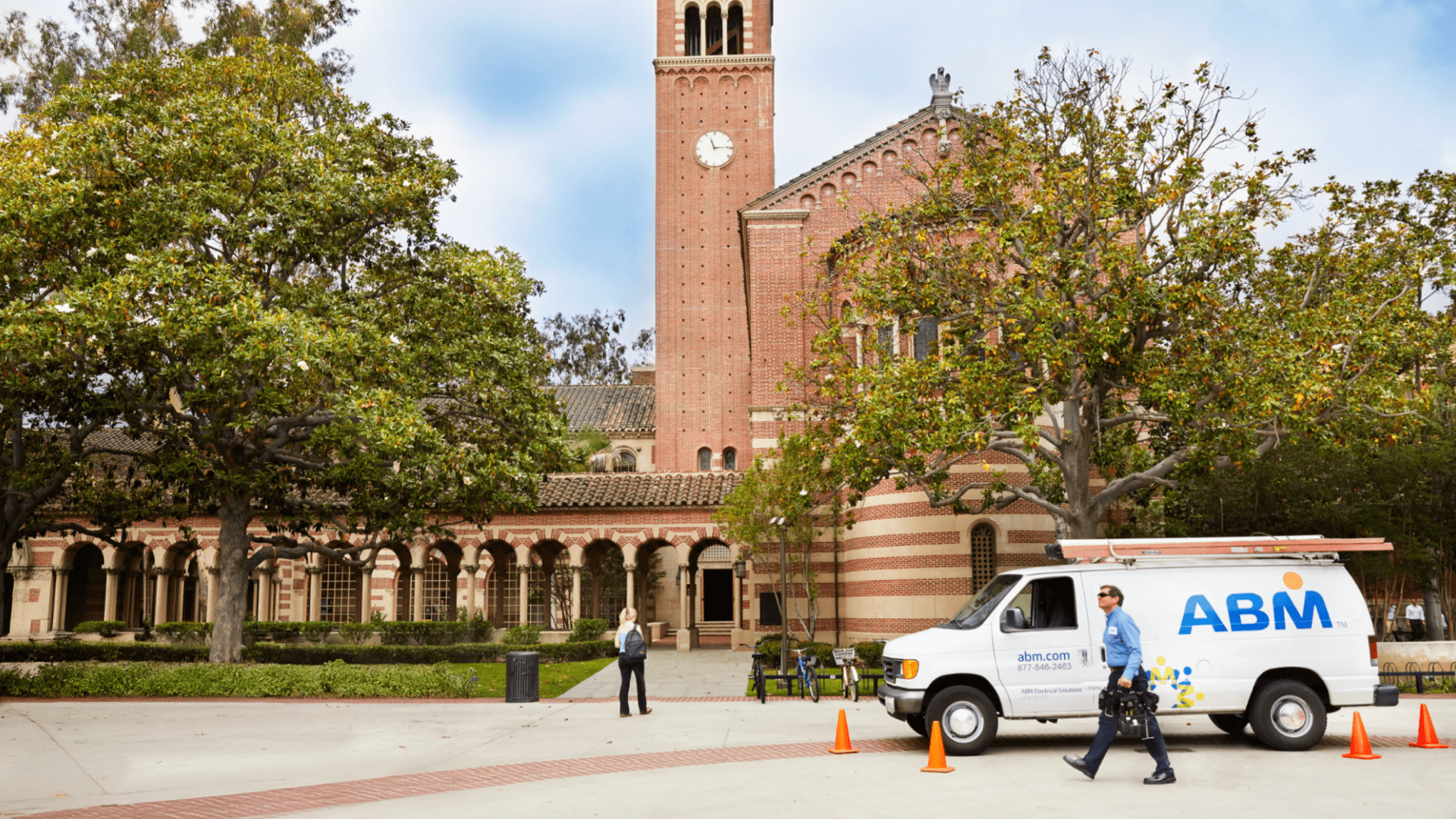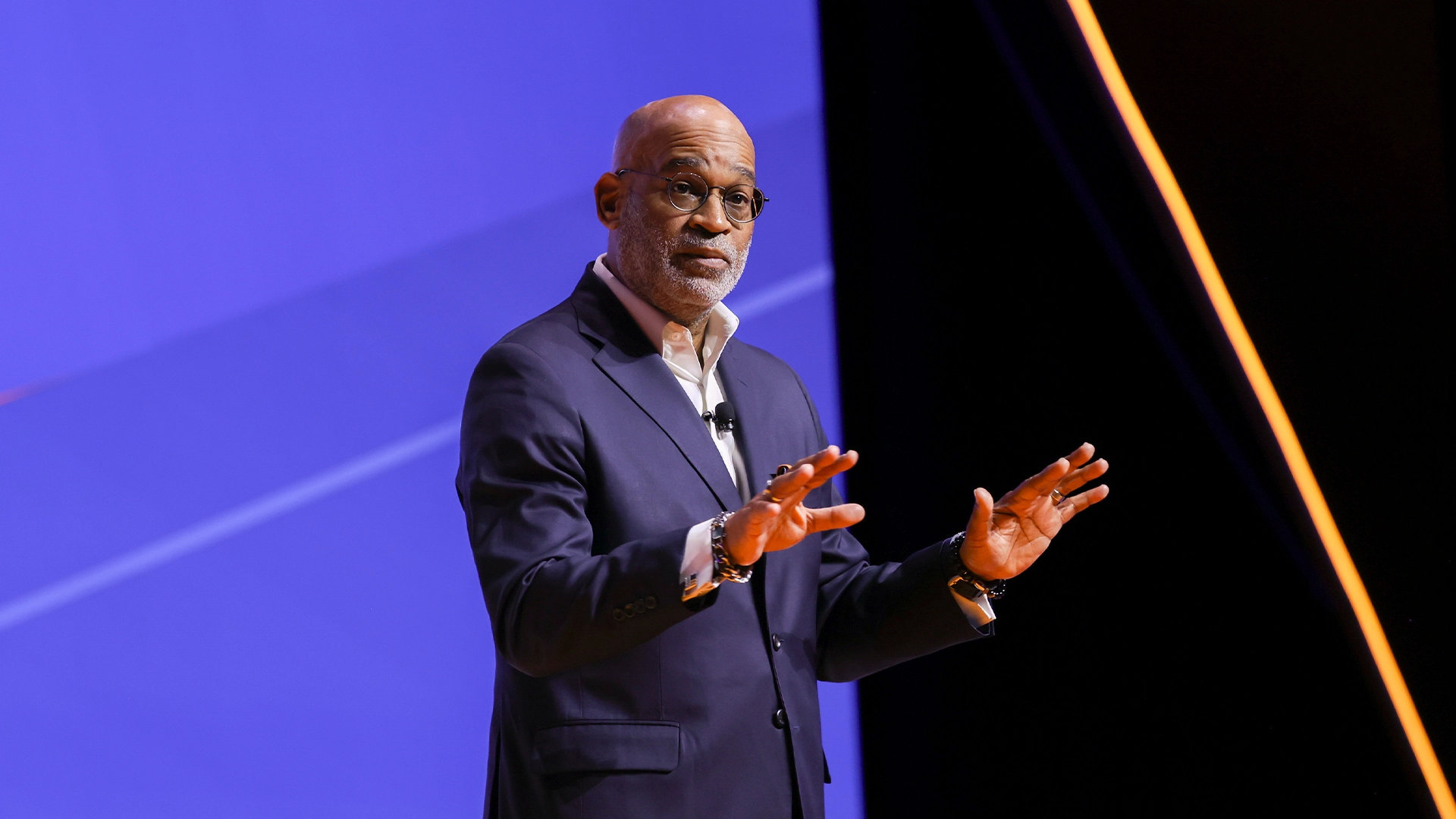Campus Operations Best Practices
Colleges face challenges like limited funding, staffing shortages, and aging infrastructure. To overcome these, they must operate efficiently, make smarter decisions, address stakeholder concerns, and prioritize a higher level of care on campus.
To make a difference, every person, every day.
ABM’s mission
To address increasingly complex challenges, such as limited funding, staffing shortages, and aging infrastructure, colleges and universities need to operate on a higher level. That means you need to be more efficient, make smarter decisions, address stakeholder concerns, and ultimately implement a higher degree of care on your campus.
For more than a century, higher education institutions have turned to ABM to address their most pressing campus challenges. In response to these top concerns, we’ve developed five areas of best practices to help you unlock new efficiencies, insights, and methods to care for your campus
Overcome staffing challenge
Colleges and universities face significant staffing challenges, including attracting and retaining qualified talent, managing turnover, and offering competitive pay and benefits. By identifying the right people and equipping them with the right tools for productivity and accountability, you can leverage labor more efficiently.
- 80% of candidates say they want faster response times from recruiters.
- 1/3 say they have quit applying for jobs because of slow response times
Best Practice Principles
Hiring
Streamlined staffing processes enable you to hire qualified, well-trained, and properly equipped facility personnel.
Focused Hiring Team
Assign talent acquisition staff to focus solely on hiring for skilled trades. Whereas many university HR departments are responsible for hiring a wide range of positions, our dedicated hiring team will more effectively create, recruit, and hire skilled trades.
Accurate Job Descriptions
We design jobs with realistic requirements aligned your campus' strategic needs and goals, so it's easier to attract the right candidates.
Competitive Messaging
ABM highlights your institution's culture and values, competitive wages, comprehensive benefits, and career development opportunities to attract great candidates.
Exceptional Candidate Experience
We demonstrate your institution's values and culture by maintaining regular communication with your talent pool and accelerating the hiring process.
Training
Provide ongoing training and professional development opportunities to improve team member performance and service quality.
Comprehensive Onboarding
Welcome new team members with an orientation program and onboarding playbook to help them navigate their first 90 days.
Safety and Site-Specific Training
Through ongoing training, we ensure team members are knowledgeable of industry standards and the needs of the facilities they work in.
Culture and Values Training
We deliver annual training aligned with our Code of Business Conduct, including harassment prevention, management training programs, and Diversity, Equity, and Inclusion training for all team members.
Frontline Leader Program
ABM's Frontline Leader Program offers education and resources that equip frontline leaders to be successful in their roles.
ABM service-level team members receive an average of 39 hours of training per year, including safety awareness and regulatory-related training.
Retaining Talent
ABM values and prioritizes team member retention, recognizing that it is crucial to maintaining the quality of facility services.
Engagement Initiatives
ABM increases employee engagement by providing team members with opportunities to provide feedback, volunteer, donate, and participate in wellness activities.
Comprehensive Benefits
ABM offers a range of comprehensive benefits, including health and welfare benefits, retirement savings, workers' compensation coverage, and paid time off.
Commitment to Diversity, Equity, and Inclusion
Our proactive outreach programs foster an inclusive workforce where everyone is seen, heard, and feels like they belong.
Team Member Appreciation
Leadership at all levels support the efforts, resources, and tools necessary to honor the hard work and dedication of facility service workers.
Career Advancement
To attract and retain talented team members, provide career advancement opportunities for employees at all levels.
Career Framework
An established career framework organizes roles and functions across the company, ensuring consistency in job titles, responsibilities, and greater transparency for career mobility and development.
Apprenticeship Programs
To nurture internal employees and prepare for future staffing needs, provide apprenticeship programs and create succession plans for technical and service staff.
System Talent Profiles
To maintain a network of talented, engaged candidates, ABM workers can build system profiles indicating their work preferences. When roles are available in their preferred location, industry, or job type, recruiters can more easily place them.
Boosting Inspection Scores with Better Staffing Practices
Challenge
A private university in Rhode Island struggled with low inspection scores and poor performance from unmotivated janitorial team members who were not meeting university standards. The inspection scores were averaging in the low 70s, far below expectations.
Solution
The university selected ABM to help address morale and performance issues. ABM identified several factors contributing to the subpar performance, including improper management, insufficient training/support, and inadequate staffing.
ABM's experienced manager implemented the ABM Way—an approach that offers excellence through documented, standardized best practices. The manager implemented training and team member appreciation programs to make the staff feel better prepared and valued. The manager also leveraged ABM's quality control program to inspect service, trend performance, and identify issues.
Benefits
By re-engaging staff with better training and accountability measures, ABM significantly improved quality, transparency, and client satisfaction:
- Increased productivity rates while reducing labor hours and supply use
- Improved performance and customer satisfaction through better communication and complaint resolution
- Improved motivation through experienced, positive leadership
- Increased quality scores from the low 70s to nearly 90 by the fifth month of the partnership
Increase enrollment with high-quality facilities
Facilities are an important consideration for parents and students. Operating a high-quality campus can help combat declining enrollment. By taking a proactive approach to infrastructure improvements and maintenance, you can enhance the campus experience and reduce long-term costs, backlogs, and project delays.
- 2/3 of college students factor campus facilities into their college decision.
Best Practice Principles
Single-source Accountability
With a single company overseeing all facility services, institutions can ensure accountability, allowing for improved efficiency and communication, as well as quicker resolution of issues.
Resources Assessment
Involve custodial and maintenance experts at the beginning of any new facility initiatives (upgrades and new architecture). ABM experts can provide guidance for the most effective and durable equipment and building product choices, which helps in maintaining clean spaces and can lower costs over time.
Proactive Maintenance and Improvement
Create a plan for proactive maintenance including steps to improve operational systems and reduce energy and resource waste.
Provide healthy spaces
Indoor environments greatly impact students in multiple ways, from attention levels to drop-out rates. Studies show that light, air, and facility quality have real effects on student success. To help your students breathe well, see well, and be well, meeting deferred maintenance needs and investing in the built environment quality is key. ABM projects create opportunities for you to improve spaces for everyone.
Energy performance contracting
ABM's national education experts can analyze your facility's infrastructure, energy usage, operating costs, and sustainability metrics. Then, we develop a solution that creates the funding needed to make recommended improvements.
Compared to the national average, schools that prioritized campus appearance and partnered with ABM have:
- 8.6% Higher application rates
- 7% Higher retention rates
- 3.5% Higher enrollment rates for new students
Improving Energy Efficiency and IAQ with Smart Capital Improvement Planning
Challenge
A public research university in Ohio needed a comprehensive, performance-based energy services and energy-related capital improvement program. The program needed to be financed through a performance-based contract with guaranteed savings at no initial cost.
Solution
ABM partnered with the university to provide a quality capital improvement program that lowered their operating costs and increased their energy efficiency. The program also ensured peak efficiency through ABM's proven preventive maintenance and training/support programs.
The solution included campus-wide lighting retrofits, consolidating 30 pieces of equipment into one boiler and chiller system, retro-commissioning mechanical equipment and air handlers, campus-wide web-based control systems, a new chilled water plant, and installing a geothermal cooling system.
Benefits
ABM helped the university to generate significant energy and operating savings:
- Energy and operating savings of $35.8 million over 15 years
- 40% reduced energy consumption
- Improved indoor air quality
- Free heating for the student center all winter or until outside air temperatures reach about 80°
- Improved the efficiency and extended the lifespan of the university's equipment
Improve the student experience
Student physical and mental health have become barriers to successful academic outcomes, including graduation rates. Maintaining a clean and hygienic campus environment is essential to ensure the health and safety of students on campus.
- 88% of students find that a lack of cleanliness can be a distraction to their learning experience.
- 78% of students report unclean areas impacted their physical health and increased their stress levels.
- Schools that partner with ABM have an average of 5% higher student satisfaction than the national average.
Best Practice Principles
Reduced noise levels
ABM can implement the following measures to reduce the impact of noise levels on student stress, anxiety, and academic performance:
- Sound insulation panels in walls
- Sound-reducing windows
- High-quality seals and gaskets on doorways
- Updated cleaning equipment and HVAC systems
Maintain Cleanliness
Through detailed policies and procedures, clear job expectations and assignments, measurable standards, and proper training, ABM ensures that cleaning operations are carried out effectively and safely.
Install Appropriate Lighting
ABM experts help facility managers identify the right lighting solutions and integrate measures-ranging from retrofits to lighting design and certification-that reduce energy consumption without sacrificing safety.
Improve Indoor Air Temperature & Quality
Improved HVAC systems and maintenance result in better indoor air quality and improved classroom performance. ABM's experts calculate ideal temperatures and energy usage, improve inside humidity levels and ventilation, and conduct proactive maintenance to extend the HVAC system's life.
Improved air quality and ventilation improved cognitive performance scores by 61%.
Creating a Cost-Effective Campus that Keeps Students Coming Back
Challenge
A private liberal arts college in Ohio needed to update its campus infrastructure and facilities to support its transformation and improve the student experience. However, declining enrollment trends and changing demographics put a crunch on the small college's budget.
Solution
ABM provided a customized preventive maintenance schedule within the college's budget, integrating janitorial, landscaping, and maintenance services, and transitioned key team members to improve operational efficiencies and results. ABM's solution also included a proactive CMMS, green cleaning practices, staff rightsizing, employee retention initiatives, safety culture, and specialty services.
Benefits
With ABM's partnership, the college was able to enhance the campus experience:
- Improved student retention by 7%
- Improved aesthetics and visual impact of campus grounds
- Updated green cleaning practices through ABM GreenCare®
Prioritize energy efficiency and sustainability
The effects of climate change are becoming more apparent, and educational facilities must take a proactive role in reducing their carbon footprint. In addition to reducing environmental impact, implementing sustainability measures can also reduce costs and improve the learning environment.
85% of college students say it is at least somewhat important for their campus to prioritize sustainability.
ABM prioritizes sustainability objectives, including green cleaning, recycling, and Energy Star and LEED certification. These sustainability efforts have helped increase student retention and generate capital through energy and operational savings.
Best Practice Principles
Cleaning Chemicals
To ensure cleanliness and the well-being of people and the environment, ABM uses Green Seal certified and bio-based cleaning alternatives, as well as electrically activated water systems that produce safe, non-toxic daily cleaning and sanitizing solutions onsite.
Waste Management & Recycling
ABM's experts can guide you through an effective waste management program that involves assessment, planning, training, and more:
- Understand waste streams
- Develop a plan to reduce waste generation
- Implement recycling and composting
E-Mobility Opportunities
To help you implement an accessible, convenient EV charging program, ABM considers the full impact of e-mobility on your campus and provides support in reaching short- and long-term infrastructure needs.
Upgrade Systems for Energy Savings
ABM can implement improvements like efficient HVAC systems, dynamic valves, and better insulation, which can lead to significant savings on energy bills and positively impact both productivity and engagement.
Driving Down Energy Consumption to Deliver Guaranteed Savings
ABM reduced a Georgia university’s energy use by 29% with Bundled Energy Solutions.
Challenge
A major university in Georgia discovered that 5% of their campus square footage was driving nearly 30% of their campus energy use. The school needed a solution that would help them reduce consumption on a limited budget.
Solution
After identifying laboratory spaces as intensive energy consumers, ABM's facility engineers investigated methods for cutting energy costs, reducing carbon footprints, and providing safer, more reliable working environments for researchers. Our energy savings performance contract provided the combined technical and financial solution needed to upgrade fume hood controls for more than 140 lab spaces without upfront costs.
Benefits
In addition to guaranteed savings of $11.7 million over a ten-year period, the project helped provide:
- Safer, energy-efficient, and more reliable research environments
- Opportunities to address deferred maintenance and existing problems
- Reduced air pressure issues and excessive air exchange rates
- Mitigated temperature extremes
- Significant gains in sustainability goals
- Reduced carbon footprint
Enhance operational excellence
Higher education institutions face a variety of challenges when it comes to managing their operations, from maintaining aging facilities to keeping up with changing technologies and student needs. To address these challenges, institutions can implement effective facilities, operations, and management (FOM) programs that prioritize quality, sustainability, and cost-effectiveness.
Higher education facilities face urgent deferred renewal of more than $112 billion.
Best Practice Principles
A well-run and sustainable FOM program is the result of a carefully orchestrated and executed sequence of events and actions, including the following:
Leadership
APPA's Leadership principles-setting direction and vision, being ethical, communicating effectively, demonstrating values, empowering staff, and promoting self-understanding-can help institutions to develop organizational culture and leadership structure to meet facility goals. 10
Build Campus Support
To foster trust and support within the campus community, ABM engages in the following practices:
- Consistent Stakeholder Communication
Providing consistent communication and performance reports is essential for building customer trust and involvement in the management process. - Ongoing Collaboration Opportunities
ABM works with institutions to define their facility goals and develop formal plans to prioritize and achieve them. Our managers document every meeting and provide follow-up to ensure all parties are aligned.
Essential Actions & Practices
There are core programs and systems that must be in place for successful and sustainable facility operations delivery. ABM implements the following practices in every facility:
- Standard Operating Practices (SOPs)
It is important to note that we develop general SOPs and customize them for each location based on their needs/goals. - Facilities Needs Assessments and Capital Planning
ABM performs assessments, maintenance procedural improvements, and upgrades to help higher education facilities address operational inefficiencies with limited capital. - Preventative Maintenance Program
By integrating labor hours, regulatory requirements, and manufacturer recommendations, ABM determines the proper actions and frequencies for preventive maintenance. - Safety Operations and Inspections
Frequent safety training, procedures, and standards are critical for preventing incidents and meeting regulatory compliance. All employees are trained and registered in Safety Inspections, Safe Work Observation Program (SWOP), and the Safety Program. - Quality Assurance (QA) Process
To track and report on program compliance and responsiveness to requests, ABM leverages a unique quality assurance program. - Labor Management
All ABM employees receive onboarding and ongoing training and are required to follow protocols for timekeeping, work scheduling, tracking parts and materials use, and performing inspections.
Platforms & Reporting
When properly installed and used, platforms like computerized maintenance management systems (CMMS) enable you to integrate systems and connect people to the right information at the right time.
To help our clients fully leverage their data, ABM employs the following practices:
- Provide reports, dashboards, and executive summaries to document performance and support planning.
- Adhere to strict requirements for record-keeping, form completion, and inspections to meet key performance indicator (KPI) targets and timelines.
- Develop and maintain accurate standards for monitoring and measuring key aspects of facility operations such as building locations and details, supply and equipment, sourcing and management, work types and priorities defined, personnel metrics, and parts and assets inventory.
Scheduled System Assessments
Post-implementation, facility partners should continue to engage with institutions to ensure that goals are being met and to identify any emerging needs or challenges.
ABM regional and local leaders meet with clients at least two times per year, or at a frequency agreed upon with the client, to discuss the following:
- Review contract specifications and compliance
- Correct staffing levels by position
- Review CMMS system
- Review compliance with ABM policies and practices
- Perform condition assessment of buildings, systems, equipment, and grounds
- Ensure SOPs are in place, followed, and documented
- Review personnel skills and training programs
- Ensure required permits, licenses, and regulatory reporting are current and on file
We create a full report of each visit with observations and recommendations for next steps.
76% of facility managers say the prioritization strategy is the most critical component to improve the effectiveness of their planned preventive maintenance operations."
Improving Operations with a Data-Driven Approach
Challenge
A private university in Pennsylvania was struggling to manage the full scope custodial services for its facilities, including cleaning, hard surface floor care, event setup and cleanup, athletic facilities cleaning, trash sorting for recycling, and residence cleaning. This led to decreased student satisfaction and unnecessary deterioration of its assets. The school was also facing budget cuts, so it needed a solution to improve cleaning and reduce costs.
Solution
Leveraging the information gathered from monthly performance reports, ABM collaborated with the university's management to identify efficiencies and opportunities to improve cleaning quality.
ABM then conducted an intensive two-week facility-specific orientation and training program for management and service workers, focusing on achieving quality and productivity goals.
Benefits
By partnering with ABM, the university was able to achieve its custodial needs and maintain a clean environment while also improving its bottom line:
- Increased productivity levels
- Decreased staffing levels
- Reduced annual expenses by more than $100,000
ABM can help you deliver a higher degree of campus care
- Electrical Power
- Landscape & Turf
- Energy
- Lighting
- EV Charging
- Mission Critical
- Facilities Engineering
- Parking & Transportation
- HVAC & Mechanical
- Specialty Services
- Janitorial
- And more
Our Values Reflect Your Values
- RESPECT
Every person brings value and is acknowledged as an asset to our team.
- COLLABORATION
We believe that we can do better and achieve more when we work together and learn from our collective experiences.
- INNOVATION
We bring fresh ideas and data-driven insights to solve business challenges. We ask: What if? Why not? What's next?
- INTEGRITY
We are sincere, trustworthy, and accountable. We tell the truth and do not tolerate behavior that breaches our values.
- EXCELLENCE
We deliver consistent, reliable service, but we don't stop there. We are committed to exceeding expectations.
- TRUST
e build confidence and demonstrate that we are worthy of keeping it.
Higher Education Experience
- 100+ Years of experience serving the education market
- 250+ Higher education institutions
- 18K+ Team members in education
- 1 Billion Sq. ft. of education space cleaned by ABM annually
Deliver a Higher Degree of Care with ABM
ABM drives possibility through facility, engineering, and infrastructure solutions across a wide range of industries. Our diverse, inclusive teams work together to advance a healthier, more sustainable, ever-changing world. Under our care, systems perform, businesses prosper, and occupants thrive. Every day, over 100,000 of us partner with our clients to care for the people, places, and spaces important to you. We are making spaces smarter, modernizing infrastructure, and transforming facilities to become more resilient.
Learn more at ABM.com/higher-ed or by calling 866.624.1520




